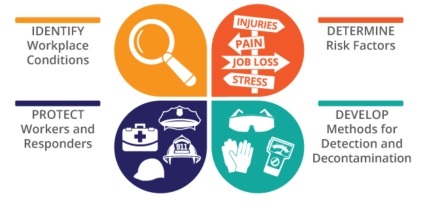
Atlanta, GA—(ENEWSPF)—August 31, 2018
Contact: CDC Media Relations
Opioid use and misuse in the workplace are a definite part of America’s opioid crisis – and the Centers for Disease Control and Prevention’s (CDC) National Institute for Occupational Safety and Health (NIOSH) has a new plan to fight it.
Approaching the crisis from an occupational perspective, NIOSH developed a framework that looks at different workplace conditions that can be risk factors for medically prescribed opioid use becoming opioid misuse. The framework also focuses on protecting first responders and includes guidance on developing methods to rapidly detect dangerously potent opioids in the workplace and how to effectively and safely decontaminate workplaces.
“The opioid epidemic reaches into every aspect of American life – including the workplace,” said CDC Director Robert R. Redfield, M.D. “CDC is working to understand the impact of different technologies to minimize risk and protect our nation’s workers and responders.”
Opioid overdoses in the workplace
In 2016, 95 percent of the 63,632 U.S. drug overdose deaths occurred among the working age population, people ages 15-64.
According to the Bureau of Labor Statistics, overdose deaths at work from non-medical use of drugs or alcohol increased by at least 38 percent each year between 2013 and 2016. The 217 overdose deaths at work reported in 2016 accounted for 4.2 percent of occupational injury deaths reported that year, as compared to 1.8 percent in 2013.
According to the 2016 National Survey of Drug Use and Health (NSDUSH), an estimated 4.5 percent of respondents age 18 years or older reported using illicit opioids in the past year. An estimated 66.2 percent of these self-reported illicit opioid users were employed full- or part-time.
A new analysis recently published in CDC’s Morbidity and Mortality Weekly Report looked at drug overdose deaths within 26 job groups and found that certain jobs, such as construction or extraction, may have a higher risk of death from opioids. This study is a first step in understanding what role work plays in the opioid epidemic and broadens the understanding of the effects a job can have on a person’s health and well-being outside of work, including the potential for increased risk of drug and opioid-related deaths.
NIOSH plan to confront the opioid crisis
The new framework includes links to resources for workers, employers, and individuals to learn more about the opioid crisis including data collection, field investigations and research, as well as tools to help. Next steps for NIOSH include continuing work with frontline responders and pursuing research to understand risk factors for use and potential abuse with a specific focus on protecting workers.
First responders and healthcare workers are at the frontlines of the opioid epidemic, facing potential exposure to potent opioids in the course of their jobs. The NIOSH Health Hazard Evaluation program is working with partners, including police departments and healthcare groups, to understand how workers may be exposed and what resources they need to work safely. The program helps employees, union officials, and employers learn whether health hazards are present at their workplace and recommends ways to reduce hazards and prevent work-related illness.
NIOSH is also working with partners from both private and public sector organizations to use workers’ compensation data to identify opioid use connected with work-related injuries.
“The opioid crisis is one of the most pressing public health challenges our nation faces today, and the workplace is not immune,” said NIOSH Director John Howard, M.D. “We are working with our partners to better understand what places workers at risk for opioid use and misuse, and identifying what research and information is needed to keep workers and first responders safe at work and in their communities.”
The NIOSH effort is part of the larger response by the Centers for Disease Control and Prevention (CDC) and the U.S. Department of Health and Human Services (HHS), which outlined a 5-point strategy to combat the crisis, including improving prevention, data collection, and research.
Source: www.cdc.gov








